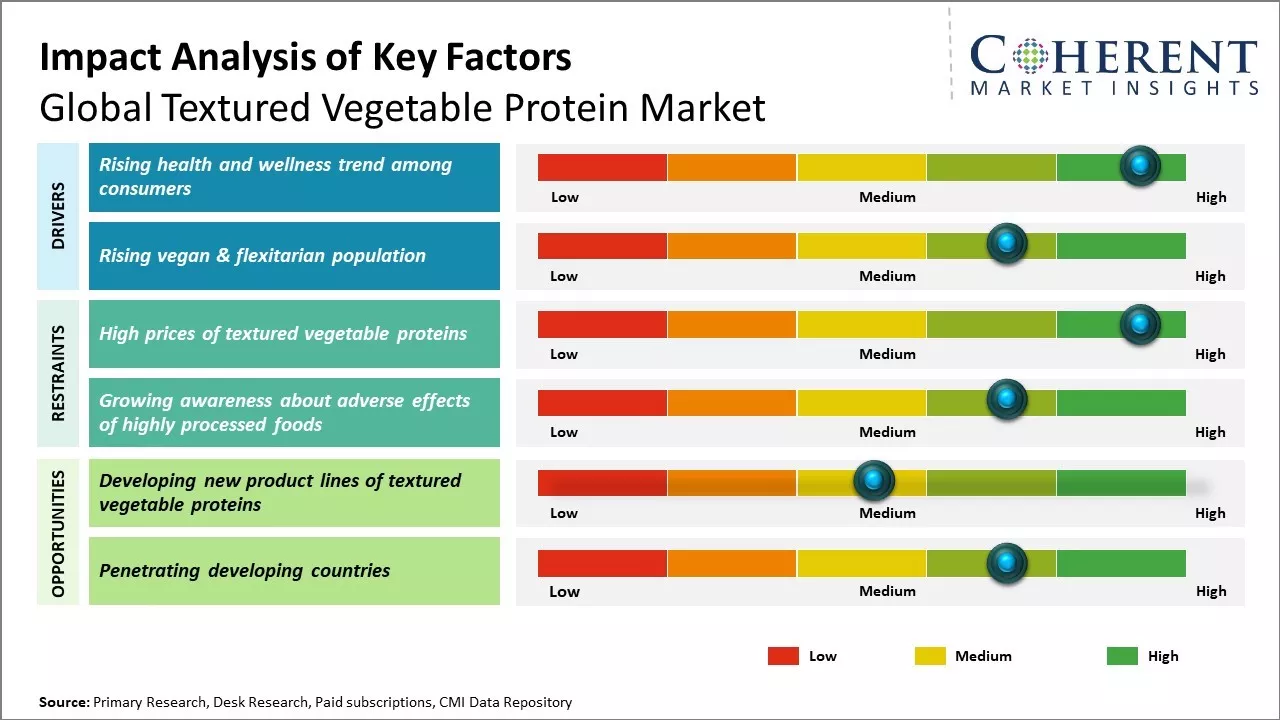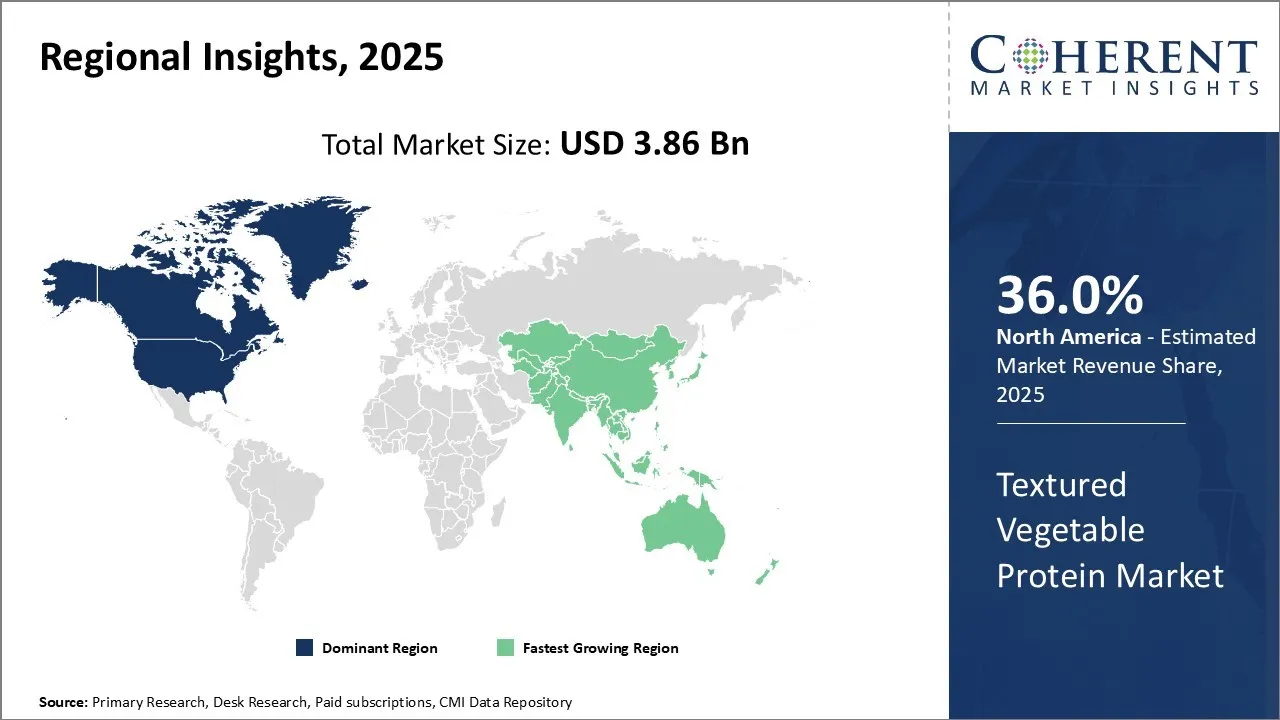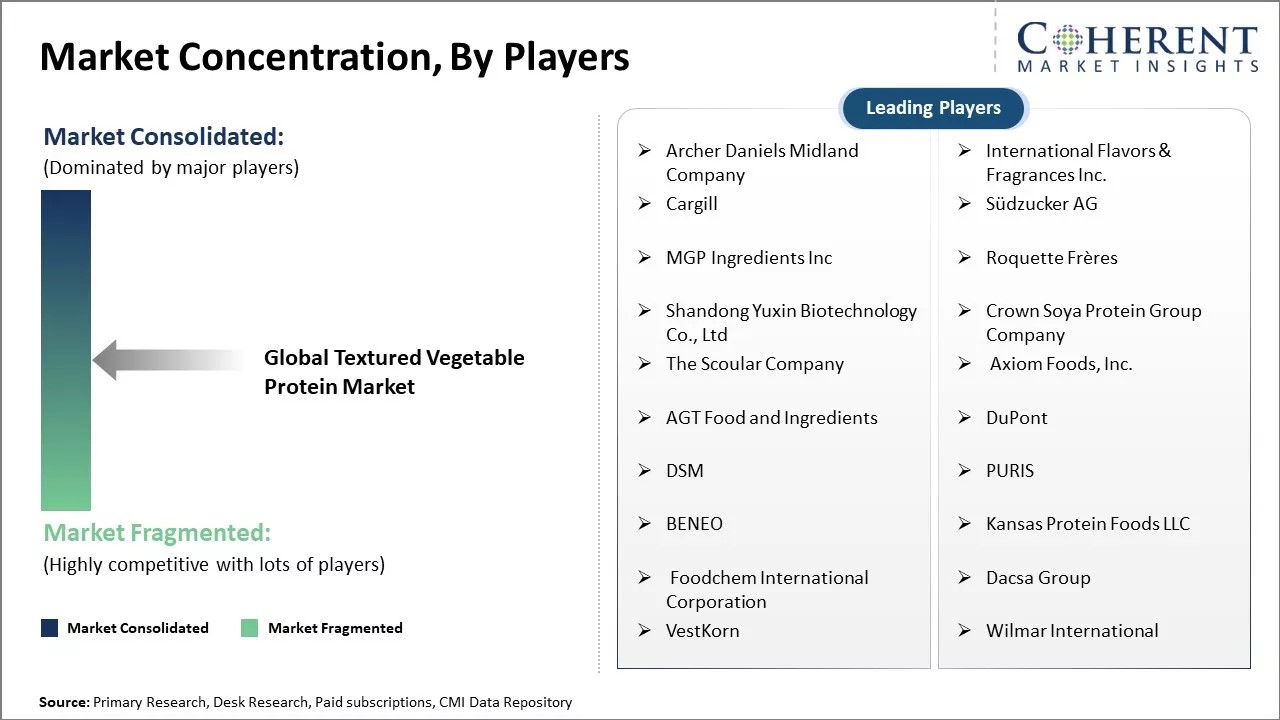The textured vegetable protein market is estimated to be valued at USD 3.86 Bn in 2025 and is expected to reach USD 6.49 Bn by 2032, exhibiting a compound annual growth rate (CAGR) of 7.7% from 2025 to 2032.

To learn more about this report, Download Free Sample
The demand for plant-based and innovative meat alternatives is increasing globally due to rising health awareness and sustainability concerns. Consumers are shifting towards vegan and flexitarian diets, which is driving the textured vegetable protein market demand significantly. Major players are investing in new product launches with improved taste, texture, and nutritional profiles to appeal to mainstream consumers. The growing food processing and fast-food industry is also augmenting the utilization of textured vegetable protein across various food applications, including ready meals, meat analogs, and snacks. However, pricing pressures due to rising input costs, such as raw materials and energy can hamper market growth over the short term, especially for smaller manufacturers operating in price-sensitive regions.
|
Current Event |
Description and its Impact |
|
Technological and R&D Breakthroughs |
|
|
Regional Consumer Dynamics and Market Expansion |
|
|
Regulatory Landscapes and Labeling Shifts |
|
Uncover macros and micros vetted on 75+ parameters: Get instant access to report
The price of textured vegetable protein market is shaped by several key factors, primarily the cost of raw materials like soy, pea, and wheat, along with processing technology, energy inputs, and regional supply-demand dynamics. As of 2023–2024, the average global price of TVP ranged between USD 1,350 to USD 1,850 per metric ton, depending on the protein source (soy being the most common), product form (granules, flakes, chunks), and degree of processing. Pea protein-based TVP, often marketed as a non-allergenic alternative to soy, tends to command a higher price, averaging USD 2,000–2,400 per ton due to higher isolation and processing costs.
In terms of regional pricing, North America and Europe see higher price points, typically in the range of USD 1,600–2,000 per ton due to stricter food-grade certification, energy costs, and labor expenses. In contrast, Asia Pacific, led by countries like China and India, benefits from more affordable production costs, with prices hovering between USD 1,300–1,500 per ton, making the region a strong export hub for TVP ingredients. At the consumer level, retail prices of textured vegetable protein products (in chunk or granule form) typically fall between USD 3 to 6 per pound, depending on packaging, branding, and whether the product is organic or non-GMO.
In terms of product type, the textured soy protein segment is projected to account for 43.8% of the textured vegetable protein market growth in 2025, driven by its affordability, functionality, and health benefits. Soy is widely available and cost-effective, making it a preferred choice for manufacturers. Its high protein content and ideal texture after extrusion allow it to mimic meat effectively in products like patties and crumbles. Additionally, consumers perceive soy as a healthy, plant-based protein linked to reduced cholesterol and heart disease risk. These factors, combined with rising interest in clean-label and sustainable diets, are fueling demand for textured soy protein globally.
In November 2024, CL Food Specialties, in collaboration with food‑tech innovator DAIZ Engineering, launched ROVITARIS® SprouTx™, a new textured soy protein engineered to tackle the taste and texture limitations of plant-based meat and seafood products. Developed using DAIZ’s proprietary germination technology, SprouTx delivers superior sensory characteristics which eliminating the typical “beany” or bitter notes, while enhancing nutrition and affordability.
In terms of application, the food product segment is projected to dominate the textured vegetable protein market share, accounting for 69.2% in 2025. This growth is driven by rising global demand for affordable protein alternatives amid population growth. Textured soy, wheat, and pea proteins are widely used in products like veggie burgers, sausages, and ready meals, appealing to both vegetarians and flexitarians.
Food processors are enhancing taste and texture through extrusion cooking and flavor masking, making TVP-based products closely resemble meat. Additionally, the convenience of pre-made, protein-rich foods support demand. Growing awareness of the environmental impact of meat is also pushing eco-conscious consumers toward plant-based proteins, helping fuel the segment’s dominance.
In June 2025, Roquette expanded its NUTRALYS® plant‑protein portfolio with two new textured ingredients: NUTRALYS® T WHEAT 600L, its first textured wheat protein, and NUTRALYS® T PEA 700XC, a large‑chunk textured pea protein. T WHEAT 600L delivers extended, meat‑like fibers, over 60 % protein, and naturally light colour that eliminates additional colouring and designed to mimic chicken texture and simplify processing. T PEA 700XC offers 70 % protein, thermal resistance, and minimal hydration needs, retaining structure and juiciness after cooking, also ideal for plant‑based ready meals and sauces.

To learn more about this report, Download Free Sample
North America has established itself as the dominant region in the global textured vegetable protein market. The region is expected to account for 36.0% of the market share in 2025. The large presence of leading manufacturers along with robust industry infrastructure and inputs availability have powered the region's supremacy. For instance, in June 2025, Global agribusiness giant Bunge invested approximately USD 550 million in a new, fully integrated soy protein concentrate (SPC) and textured soy protein concentrate (TSPC) facility adjacent to its existing soybean crushing operation, in Morristown, Indiana. When operational, the plant will process an additional 4.5 million bushels of soybeans annually and create about 70 full‑time jobs.
Major players have their headquarters and manufacturing facilities well-entrenched here, allowing them to address the large domestic demand as well as tap growth opportunities in other key markets. Additionally, North America is one of the largest producers and exporters of soy and wheat, which are the primary raw materials used for producing textured vegetable protein. The low-cost and easy access to raw materials provides manufacturing competitiveness to companies operating here.
Asia Pacific region is considered as the fastest-growing market in the textured vegetable protein market. Rapid urbanization, rising health consciousness, and increasing adoption of vegetarian and flexitarian diets have been driving the protein demand across many countries in the region. The region is home to nearly 60.5% of the world's population including two most populous nations - China and India. Both these markets have shown strong year-on-year growth momentum. The pricing of textured vegetable protein products is also relatively affordable for the masses in Asia Pacific countries compared to animal-based alternatives.
Many local and international brands have been leveraging the growth opportunities by introducing new product varieties, expanding distributions networks, and raising marketing spend. For instance, in June 2025, Prot, formerly Seaspire, has launched Prot Block, a shelf‑stable, pea‑based protein block formulated to address widespread protein concerns in India. Offering 15 g protein and 10 g fiber per 100 g with only 7 g fat and its nutrition profile rivals tofu while staying lighter than paneer. Available in plain and tandoori flavours, the neutral‑textured block is designed to fit seamlessly into everyday meals, from curries to sandwiches. With plant‑based diets growing rapidly, driven by health priorities over affordability, and 73% of Indians reportedly protein‑deficient, Prot aims to become an accessible alternative for vegetarians across markets.
The region's rising exports, driven mainly by India and China, indicate its prominence as a future global sourcing hub. The ongoing trade negotiations could potentially provide further impetus to the intra-regional and global trade activities involving textured vegetable proteins.
The United States is the largest market for Textured Vegetable Protein market is driven by a high number of flexitarian consumers, growing demand for plant-based meat alternatives, and strong retail presence through major chains like Walmart and Whole Foods. For instance, according to Food Institute, in 2023, 1 in 2 U.S. households are already buying plant-based foods, and 98% of consumers who buy plant-based protein alternatives also buy animal meat. Additionally, the same study revealed that 72 million households in the U.S. are flexitarian. Leading companies such as Beyond Meat and ADM are innovating with TVP to improve texture and nutrition in meat substitutes, snacks, and ready meals. The market is further supported by health, environmental, and animal welfare concerns, as well as increased adoption in foodservice and institutional channels. Overall, the U.S. remains a key growth hub for TVP demand.
In China, the textured vegetable protein market is experiencing rapid growth, driven by a rising middle class and increasing health awareness. Consumers are shifting toward high-protein, plant-based alternatives due to concerns over food safety, nutrition, and sustainability. TVP is increasingly used as a meat substitute in traditional dishes like dumplings, stir-fries, and hot pots, as well as in convenience foods such as instant noodles and ready meals.
Overall, the main reasons for consuming plant-based food were health (46%), nutrition (39%), and food safety (35%). Only 24% of consumers are motivated by climate concerns. Notably, 56% of Chinese people believe that plant-based diets help lower BMI and reduce obesity, which in turn can lower the risk of heart disease, stroke, high blood pressure, and high cholesterol. As a result, China is emerging as a key growth market, backed by government interest in food security and domestic innovation.

To learn more about this report, Download Free Sample
| Report Coverage | Details | ||
|---|---|---|---|
| Base Year: | 2024 | Market Size in 2025: | USD 3.86 Bn |
| Historical Data for: | 2020 To 2024 | Forecast Period: | 2025 To 2032 |
| Forecast Period 2025 to 2032 CAGR: | 7.7% | 2032 Value Projection: | USD 6.49 Bn |
| Geographies covered: |
|
||
| Segments covered: |
|
||
| Companies covered: |
Archer Daniels Midland Company, International Flavors & Fragrances Inc., Cargill, Südzucker AG, MGP Ingredients Inc, Roquette Frères, Shandong Yuxin Biotechnology Co., Ltd, Crown Soya Protein Group Company, The Scoular Company, Axiom Foods, Inc., AGT Food and Ingredients, DuPont, DSM, PURIS, BENEO, Kansas Protein Foods LLC, Foodchem International Corporation, Dacsa Group, VestKorn, and Wilmar International |
||
| Growth Drivers: |
|
||
| Restraints & Challenges: |
|
||
Uncover macros and micros vetted on 75+ parameters: Get instant access to report
One of the key drivers of the textured vegetable protein market research is the global rise in health and wellness awareness. Consumers are increasingly prioritizing protein-rich diets, while also shifting toward plant-based sources due to ethical concerns, sustainability goals, and reduced meat intake. Textured vegetable proteins (TVPs) like soy, wheat, and pea offer a cholesterol-free, lactose-free alternative, mimicking meat textures in forms like chunks, strips, and granules. Their neutral taste and versatility appeal to both vegetarians and flexitarians.
According to recent data, 53% of Americans have tried plant-based meat, with 40% consumed it in the past year. Additionally, 24% are monthly users. In India, GFI reports that Mumbai leads as the vegan capital, with 37% of restaurants in major cities offering plant-based meat options. This surge in demand continues to fuel innovation and adoption in the textured vegetable protein market.
The rising health consciousness among people around the world, coupled with growing awareness about the environmental impact of meat consumption, is driving more individuals to adopt vegan and flexitarian diets. This paradigm shift towards plant-based eating has significant implications for the textured vegetable protein market. Textured vegetable proteins such as soy, wheat, and pea proteins are increasingly becoming popular alternatives to meat as they can mimic meat fibers and textures when processed.
Food manufacturers are proactively developing vegan meat analogues and other meat substitutes using textured vegetable proteins to cater to the dynamic preferences of modern consumers. Notably, according to Care Health Insurance, the global vegan population is growing rapidly, with 79 million people currently identifying as vegans. Animal welfare, environmental and health impact, and sustainability are the main influencing factors behind this shift. In the U.S., 47% of consumers identify as flexitarian, with a notable increase in the consumption of plant-based products, further fueling the demand for textured vegetable proteins.
Developing new product lines of textured vegetable proteins could provide great opportunities for companies in this expanding market. As consumer preference shifts towards more plant-based, sustainable protein options, textured vegetable proteins are well-positioned to fill this demand. Product innovation that keeps up with evolving tastes will be key to future growth. New variations in flavors, textures, and formats have the potential to attract both health-conscious consumers looking to cut back on meat as well as flexitarians interested in occasional meat-free alternatives. Launching textured proteins designed to directly replace specific meats could drive further market expansion. For example, developing texture profiles and seasoning to mimic bacon bits or ground beef crumbles would allow plant-proteins to slot easily into favorite recipes. As population growth increases the need for resource-efficient proteins, products tailored after widely consumed meat staples may appeal to cost- and environment-conscious new customers.
According to a report From Deloitte and GFI India, there are over 100 start-ups innovating across plant-based, fermentation-derived, and cultivated proteins, spread across 23 Indian cities. India’s smart protein market, currently valued at Rs 350 crore (nearly $42 million), is expected to reach $4.2 billion by 2030 reflecting a strong textured vegetable protein market forecast.
The textured vegetable protein market value is undergoing a transformative phase, not merely as a substitute for meat, but as a category that is redefining how food systems innovate around sustainability, affordability, and protein scalability.
What sets textured vegetable protein apart in this protein transition narrative is not its alignment with lifestyle-driven plant-based trends, but its alignment with structural food security. As per 2023 USDA procurement data, over 18,000 metric tons of soy-based protein isolates and concentrates, including textured vegetable protein were purchased for use in federally funded nutrition programs. That volume dwarfs niche alt-protein ingredients such as mycoprotein or cultured meat. textured vegetable protein’s affordability, ease of storage, and protein content (typically 50%–70%) make it uniquely suited for institutional buyers navigating strict cost-per-serving thresholds.
A telling example is India's mid-day meal scheme, which has piloted soy-based textured vegetable protein in multiple states as a low-cost protein to replace more volatile animal protein sourcing. Similarly, the European Food Banks Federation has partnered with producers of pea- and wheat-based textured vegetable protein s to distribute shelf-stable, protein-rich meal kits to low-income households across Southern Europe. These are not speculative use cases, they represent an infrastructural shift in protein procurement logic.
Technologically, extrusion processing continues to evolve toward higher moisture retention and improved texture fidelity. The recent surge in high-moisture extrusion systems has enabled companies to mimic fibrous meat textures in minimally processed formats, particularly for pork and chicken analogs, driving adoption in quick-service restaurants (QSRs) in South Korea and Singapore. In fact, CJ CheilJedang’s plant-based Bibigo dumplings, which rely on wheat and soy textured vegetable protein, accounted for 12% of their global frozen food revenue in 2024, reflecting how Asian QSR giants are quietly scaling textured vegetable protein without adopting Western-style branding.
However, the market’s long-term resilience will depend on de-commoditizing TVP through functional ingredient customization. Emerging players in North America are integrating mushroom extracts, fermented fibers, or oil-infused microspheres into TVP granules to improve flavor-binding, umami depth, and iron bioavailability. In my opinion, the ability to offer functional differentiation beyond texture is where true margin capture lies.
To conclude, the textured vegetable protein market is not merely a derivative of the broader plant-based narrative. It is a fundamentally utilitarian ingredient platform that thrives in constrained food economies. Its growth is unlikely to be flashy, but it will be foundational.
*Definition: The textured vegetable protein market involves products made from soy, wheat, or pea proteins that are textured or structured to resemble meat or animal products such as chicken, beef, or fish. These textured vegetable proteins are used as meat substitutes or extenders in foods like soups, stews, casseroles, and vegetarian foods. They provide protein and texture to support growing demand for meat alternatives from health-conscious and vegetarian consumers. Textured vegetable proteins help meet this demand through their ability to mimic popular meat dishes while using plant-based ingredients.
Share
Share
About Author
Sakshi Suryawanshi is a Research Consultant with 6 years of extensive experience in market research and consulting. She is proficient in market estimation, competitive analysis, and patent analysis. Sakshi excels in identifying market trends and evaluating competitive landscapes to provide actionable insights that drive strategic decision-making. Her expertise helps businesses navigate complex market dynamics and achieve their objectives effectively.
Missing comfort of reading report in your local language? Find your preferred language :
Transform your Strategy with Exclusive Trending Reports :
Frequently Asked Questions
Joining thousands of companies around the world committed to making the Excellent Business Solutions.
View All Our Clients